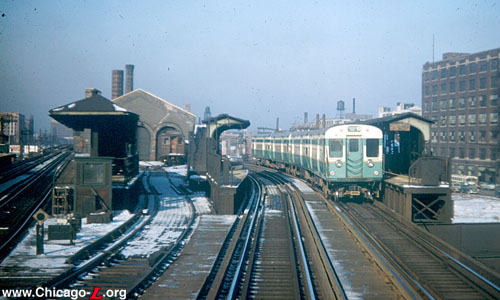|

Racine station is seen looking west as a 6000-series Douglas Park "B" train stops at the platform on track 1, sometime between 1952 and September 1953. Three of the four Racine platforms are visible in this view; the fourth, on track 4, is out of view to the left. The Throop Shop, the Met Division's former primary heavy maintenance facility, is in the background and was in the process of being phased out. For a larger view, click here. (Photo from the Krambles-Peterson Archive)
|
Racine
(1200W/400S)
Racine Avenue and Van
Buren Street, Near West Side
Service
Notes:

|
Garfield
Line/Douglas Line
|
Quick Facts:
Address: 416-18 S. Racine Avenue
Established: May 6, 1895
Original Line: Metropolitan West Side Elevated
Previous Names: Centre Avenue
|
Skip-Stop Type:
|

|
Station
(1951-1953)
|

|
Station
(1953-1954)
|
Rebuilt: n/a
Status: Demolished
History:
The Centre Avenue station (spelled "Center" on some maps; later, renamed Racine station) opened in 1895 when the Metropolitan "L"
first opened. It was located on the four-track Metropolitan
main line, on which all three branches of the Met -- the
Northwest
branch, Garfield Park
branch, and Douglas
Park branch -- entered downtown Chicago.
An 1897 inventory of the Metropolitan "L" described the station houses on the Met main line as being "similar to those of the Garfield Park branch, but larger." Indeed, like these, the station houses at Centre and the other Met main line stations were constructed of red pressed brick with stone sills and foundations. The most obvious difference in design from their Garfield Park (and Northwest branch) brethren is the lack of the semicircular bay/portico on front which was characteristic of these other Met headhouses, instead having a flat front elevation. The interior was described as having painted walls and ceiling with hard wood finishes, and equipped with a ticket booth, newsstand, water closet, and a water heater in the basement.
As originally built, all four Met main line stations, including Centre, had dual island platforms, each set between the pairs of outer and inner tracks. The stairs and platforms were constructed of
wood on a steel structure. Each platform had a short canopy in the
center of the platform, covering the stairs and about 2/3 of the original platform length. The canopy frame was iron, with a hipped roof of corrugated tin. The inner tracks at each station were tangent, while the outer tracks bowed out to make room for the platform between the outer and inner tracks.
Between 1898 and 1914, the track and platform configurations at Halsted, Centre and Laflin were altered. A valuation report for the Metropolitan elevated described the original island platforms as having "very sharp swings in the track at each end of the platform. These were so sharp as to be a source of danger..." As a result, the Met embarked on a project to shift the structure, install new foundations, reconfigure the platforms, and change the profile of the tracks on both sides of the platforms. It is not clear why the project took 16 years, even if done under traffic, nor if it was done one station at a time or if more than one station was worked on at a time. At Centre, the result was a somewhat unusual configuration: four side platforms
on the west side of Centre Avenue. The station was located a block east of the Metropolitan
Division's Throop Street
Shop, their main maintenance facility, which was located between
the tracks. Because the tracks split in two pairs to go around the shop, a side platform was provided on each track, connecting to the station house on the west side of Centre Avenue.
Centre
Avenue was renamed Racine Avenue in 1913. The station changed names with the street.
In 1951, trains between downtown and Logan
Square were rerouted from their Milwaukee-Paulina alignment via Marshfield and the Metropolitan Division main line into the Milwaukee-Dearborn
Subway, which continued under Milwaukee, Lake Street, Dearborn, and Congress, originally ending at LaSalle/Congress. Garfield
Park and Douglas
Park trains to and from the Loop,
however, continued to operate over the old Met
main line and through Racine for the time being.
Within a couple years, however, the Met Division main line and Garfield Park branch began to be gradually abandoned to allow for its demolition to make way for the construction of the Congress Superhighway (later, Eisenhower Expressway). In September 1953, the Garfield
Park Line was rerouted via temporary ground-level trackage along
the south side of Van Buren Street between Sacramento and Aberdeen. The temporary ground-level Garfield tracks rejoined the elevated near Aberdeen, east of Racine station. This rerouting of Garfield trains meant they no longer utilized the Racine station and permitted demolition of the Garfield Park elevated structure between Sacramento and Marshfield for highway construction.
For the time being, however, Douglas trains continued to use the Met main line east of Marshfield, and were the sole tenant of the old Met main line between Marshfield and Aberdeen. Douglas trains used tracks 2 and 4 in this section, and since tracks 1 and 3 were not in regular use there the side platforms on those tracks were closed, leaving only the track 1 and 3 platforms in service. On September 20, 1953, Racine changed from a "B" station to an "AB" station.
This setup would be short-lived, however. The next phase of abandonment came when Douglas trains were rerouted to the Loop via the Paulina Connector and Lake Street on April 4, 1954. This allowed for the abandonment of the Metropolitan main line elevated structure from Marshfield Junction to Sangamon Street, and with it the closure of Marshfield and Racine stations.
A replacement station, Racine,
was opened on the Congress
Line.



